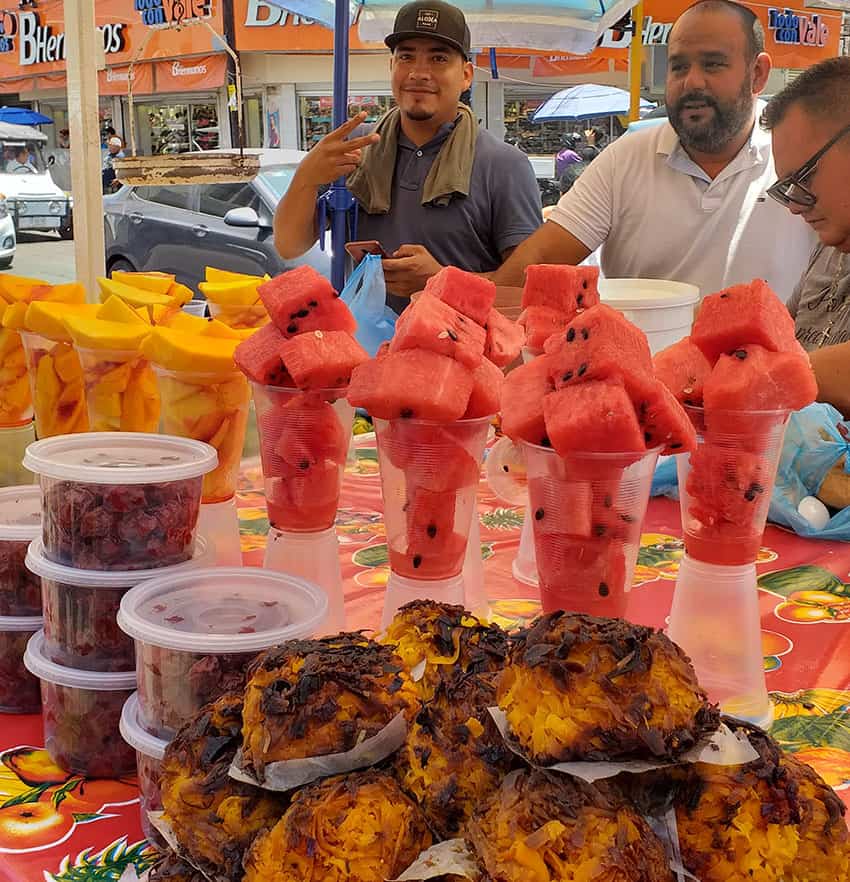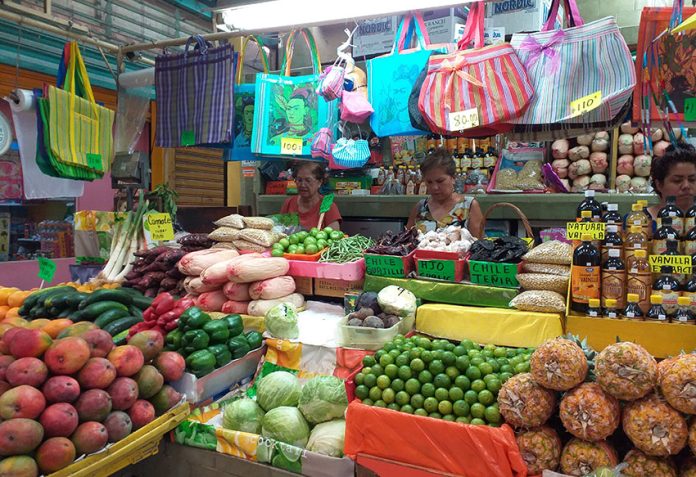Since I moved to Mexico, grocery shopping has become one of my most enjoyable activities. In fact, when I have visitors, it’s one of the first things I do with them.
Why? Because the local mercado, or market, is just a hoot.
There’s just no way not to smile as you wander through aisles crammed with stalls offering everything from voodoo spells and evil-looking statues to Frida Kahlo shopping bags, pure vanilla extract (about US $8 for 16 oz.) and caramelized sweet potatoes.
Ladies prepping nopal cactus – a staple in Mexican cuisine, added to salsas, stews and tacos – sit between colorful piñatas for sale and fishmongers with fresh shrimp of all sizes, deep red tuna or just-caught snapper (under $5 a pound, in season) smoked marlin (the delicious south-of-the-border replacement for lox).
There are literally piles of fresh fruits and veggies, spices and dried herbs, cheeses, fresh seafood, and meats (cut to order!) and bakery-fresh pastries. It’s a chaotic flurry of activity that definitely qualifies as delicious entertainment in my book.
Then there’s all the other “stuff:” souvenir hats, t-shirts and shot glasses, clothing, purses and luggage, shoes, toys, bobble-head refrigerator magnets, sunglasses, kitchenware. You never know what you’ll find! And around the outside of the market, there are usually all sorts of food stands, with tacos, agua fresca, cups of cut-up fruit and more.

Most folks who move to Mexico find shopping at their local mercado gets them the best prices, the biggest selection of local and in-season produce, like lychees or mangos. (Where I live, mangos in season are $1 for 5 lbs., which is about eight.)
It’s also a rich cultural experience that never gets old. While you may still want to go to a “regular” grocery store for certain items (like imported cheeses, alcohol and a bigger selection of packaged goods), your local market can provide you with all the basics and is also a good way to meet your neighbors and learn about Mexican cuisine.
Although you might not be looking at signs, a simple Spanish lesson may be helpful: Adding the suffix –ría to a word indicates what is happening there. So, at a carnicería, meat “happens,” at a dulcería, candies “happen.”
You’ll see cremerías (dairy products), panaderías (breads and pastries), fruterías (fruits) and maybe loncherías (lunch places).
Be forewarned that the meat section can be off-putting, piled as it is with parts of animals we don’t usually see: whole heads, feet, tongues, beaks, et al. All parts — and I mean all — are sold.
Everything can be cut to order; learn the words in Spanish so you can ask for what you want. Meat is displayed in open-top refrigerated counters, and despite what seems like a shocking lack of hygiene to our expat minds, this is how it’s done here. (That said, it can’t hurt to go to what looks like the cleanest and busiest butcher stand.)
I have a favorite chicken vendor, who receives fresh (not frozen), whole chickens every morning and will cut to order as you like. The other day I asked if he could grind the meat so I could make burgers. Chava said he didn’t have a grinder, but that he could chop it very, very fine. He suggested leg meat would have the most flavor.
In the blink of an eye he had the skin off and the meat fileted from six drumsticks, then proceeded to mince the meat for about 20 minutes, all the while chatting with me and other customers. He ended up with enough chicken for four good-size burgers. And the cost? Forty-eight pesos, barely $2.50. What’s not to love?!
Fresh fish and shellfish are also sold from open refrigerated counters, often with ice on top too. The vendor will ask if you want bones cut out or the fish fileted thin. In season, there’s farmed and wild shrimp, clams, scallops and sometimes crabs. They also have ground fish for making “meatballs” for soup (quite yummy!) or burgers.
There are also stands with all kinds of dried fruits, nuts and seeds, often packaged in small bags that are just right for snacking or taking on trips. And of course you’ll find a big selection of dried chiles and spices, some familiar and some not.
Dried beans, rice, tamarind, fresh turmeric and ginger root, Jamaica flowers (for tea), and piloncillo – raw brown sugar, in small blocks – are all sold by the ounce. Although it’s a bit of work to grate the piloncillo for baking and such, the flavor is delicious and I find it well worth the effort.
I also find it charming and convenient that produce vendors will make packages of, say, soup ingredients: an onion, half an ear of corn, a handful of cilantro, two tomatoes, a potato, some celery and maybe cabbage. These will cost about $1 and are just right for throwing into a pot with some sort of protein, rice or pasta, salt and spices. Voila!
Half a papaya, cantaloupe, head of lettuce, cabbage or watermelon; two stalks of celery, a handful of fresh parsley, one egg – anything and everything is happily possible.
Rather than feeling bewildered by the warren of aisles and apparent chaos you’ll encounter, try to go with the flow and take time to explore. Eventually it will start to make sense, and you’ll see different sections, with butchers, bakeries and produce stands more or less clustered together.
Scattered throughout will be deli-like stands with dairy products, fresh cheeses, eggs (often sold by weight, about 10 for $1) tortillas and such, and also abarrotes shops, with canned and packaged goods. Bringing your own shopping bag will make it easier to carry your purchases.
Janet Blaser of Mazatlán, Sinaloa, has been a writer, editor and storyteller her entire life and her work has appeared in numerous travel and expat publications as well as newspapers and magazines. Her first book, Why We Left: An Anthology of American Women Expats, is available on Amazon. Contact Janet or read her blog at whyweleftamerica.com.
